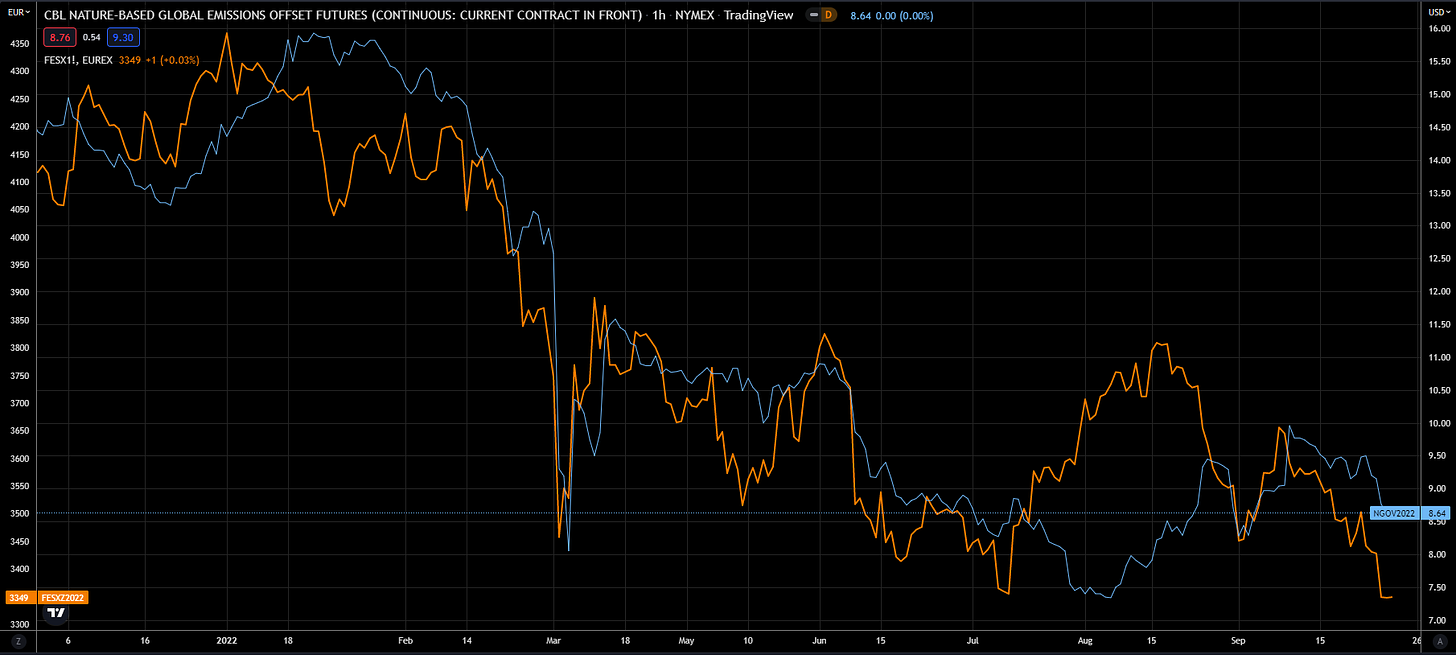VCM futures no refuge from equity market malaise
Strong corporate demand for carbon credits masks declining willingness to pay
The voluntary carbon market (VCM) has all the features of being an ideal asset for investors seeking uncorrelated returns.
Climate change is a long-term issue that will require a fundamental reorganisation of the global economy. Emissions may ebb and flow, but the longer term trend does not pay much regard to the business cycle, changes in financial liquidity, nor trends in energy and commodity prices.
The carbon credit market must grow if the world is going to meet it’s net zero targets. According to recent analysis from EY the volume of carbon credits supplied will need to grow 30-40 times by 2035 if the world is going to meet scenarios consistent with the Paris Agreement on climate change (see The planet's carbon removal scarcity problem).
By the end of Q1 2022, almost 3,000 companies had either approved or committed to setting net-zero targets in line with the Science Based Targets Initiative (SBTi), according to Trove Research. The six-fold increase in commitments over the past two years points towards a strong increase in demand for carbon credits from the corporate sector.
Over the long-term you would expect the price of carbon credits in the VCM to be determined by the marginal abatement cost of various offset projects - nature-based offsets being towards the lower end of the cost curve, while lower volume, often unproven technology-based offsets located towards the steep end of the curve (see Technology-based carbon removal credits crucial if net-zero targets are to be met).
In addition to buyers preferences for certain types of carbon offset projects (i.e. nature versus technological, abatement versus removal, the degree of co-benefits, etc.), the outlook for credit prices should depend on degree to which there exists a pipeline of high quality projects to meet the anticipated strong demand growth.
In short, VCM futures contracts should reflect market participants expectations of how these underlying fundamentals will evolve (see GEO versus N-GEO: Investing in the VCM futures market).
However, that’s not what the data shows.
The Nature-Based Global Emissions Offset (N-GEO) futures contract has tracked equity markets step-by-step since the contract was launched towards the end of 2021. Apart from a period of relative weakness in early August, the N-GEO contract has closely followed the risk-on, risk-off nature of global equity markets. Much like the broader equity market, it’s been the outlook for inflation, real interest rates and global liquidity that have been the key driver of carbon credit futures prices.
Chart: N-GEO futures contract versus Euro Stoxx 50
Why is the VCM market behaving like this? Isn’t it supposed to be an uncorrelated asset?
Although declining stock prices reflect a deteriorating outlook for the economy and declining earnings prospects, a fall in an individual company’s stock price can adversely affect the behaviour of its management. Lower stock prices may make it more difficult for a company to fund investments, especially those that drive longer term returns or look to mitigate emerging risks. To the extent that the equity market is a mirror on social mood, a bear market paints a dark picture for the corporate voluntary carbon market.
According to Trove Research, the carbon credit purchasing behaviour of most corporates is akin to them buying a luxury good, not a necessity. In short, buyers are very price sensitive and will pushback at shelling out more cash than they feel they need to.
As economic pressure increases, corporate budgets will come under more pressure. Short-term survival trumps long-term commitments to tackle climate change. Price sensitive purchasing behaviour was hidden when the economy was motoring along, only emerging when things start to look bleaker.
Demand growth from the corporate sector may be strong, but the market needs to reckon with willingness to pay. And right now that’s looking weak.
As long as investors have their eyes wide open to current market dynamics, and that equity bear markets can go on for much longer than seems possible, then recent low carbon credit futures prices represent an opportunity for long term investors.
EY project that carbon credit prices could rise from under $25 per tonne to $80-150 per tonne in 2035, and continue to rise to $150-200 per tonne in 2050 (in real 2020 dollars).
This assumes that countries and companies move reasonably quickly to implement on-ground actions and policies that are consistent in aggregate with the Paris Agreement to limit climate change to well below 2°C.
However, EY contend that even higher carbon credit prices are likely if “delayed or disorderly action requires greater ‘catch-up’ effort after 2035 (to achieve the same budget), or if market friction is more significant and persistent.”
As energy security, geopolitical and macroeconomic concerns push worries about the climate down the agenda, it feels very much like we are moving towards a path of “delayed or disorderly action”.
That may be a precursor to much higher VCM futures prices in the years ahead. In the meantime, corporate buyer sentiment towards carbon credits at least is more than likely to be determined by the direction of the stock market than anything else.






